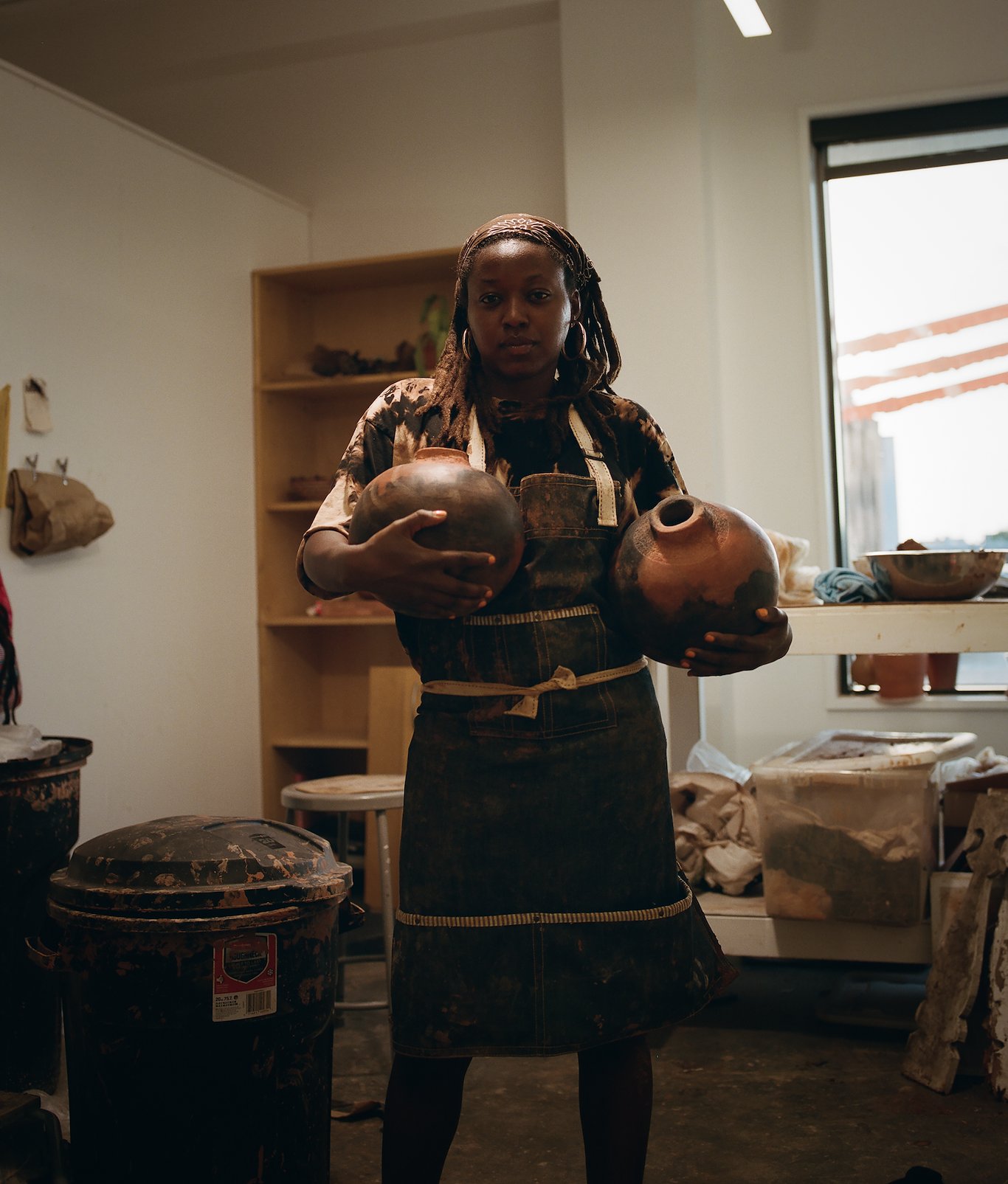
Adebunmi Gbadebo is a multimedia artist who uses culturally imbued materials to investigate the complexities between land and memory in the American South. Gbadebo has developed a unique visual vocabulary by focusing on deeply significant elements such as indigo dye, soil manually scooped from plantations, and Black human hair gathered from all around the world. The histories of ancestors, relatives, and people who were either long forgotten or overly attentively watched are frequently told in the subsequent works. Gbadebo, who was raised in New Jersey and now divides her time between Newark and Philadelphia, has a Creative Place Keeping certification from the New Jersey Institute of Technology as well as a BFA from the School of Visual Arts in New York.
The exhibition Hear Me Now: The Black Potters of Old Edgefield, South Carolina, which was on display from September 9th to February 5th at the Metropolitan Museum of Art in New York had ceramics by Adebunmi. She is an artist in residence at the Clay Studio in Philadelphia and a 2022 Pew Fellow. Popular media like the New York Times, Hyperallergic, Hypebeast, Brooklyn Rail, Forbes, and the American Craft Council magazine have all reported about Gbadebo. Gbadebo has spoken at the Museum of the African Diaspora and the Newark Museum of Art. He has also been featured on BBC Newsday. She participated in a panel discussion at the Met on December 3, 2022, about land and memory in relation to her work and the enslaved potters Old Edgefield, SC.
Gbadebo’s works are included in the permanent collection at the Smithsonian National Museum of African Art, Smithsonian National Museum of African American History and Culture, the Minneapolis Institute of Art, the South Carolina State Museum, the Boston Museum of Fine Arts, the Newark Museum of Art, amongst others. Gbadebo has presented in exhibitions across the US and internationally at the Dhaka Art Summit, Bangladesh, and the 1-54 African Art fair, London.
She is the current Community Engagement Apprentice for the Harriet Tubman Monument being built in Newark, NJ, to replace a statue of Christopher Columbus in the former Washington Park, newly named Tubman Square. The monument is set to open to the public in March 2023.

Image courtesy of Forbes
Solo Show “REMAINS”
On view January 13 – March 11, 2023, the exhibition continues Gbadebo’s years-long exploration of her ancestral origins centered on the plantation on which her forbearers were enslaved and currently buried, called True Blue in Fort Motte, South Carolina.
Gbadebo explores this genealogy in her work, which includes both traditional pottery pieces made from the soil where her enslaved ancestors were interred and innovative multi-media paper works made from indigo, rice paper, cotton, and human hair. These will be on exhibit along with historical items recovered from antebellum architectural ruins from buildings constructed thanks to the efforts of her ancestors.
This exhibition will debut at Claire Oliver Gallery before moving to the Weisman Art Museum in Minneapolis throughout 2023-24.

Image courtesy Claire Oliver Gallery
On February 11, Forbes writer Alexandra Bregman wrote about “Remains” a recent solo show at Claire Oliver Gallery in Harlem, collective memory and generational trauma take on new depths. “Among the rich and varied mixed media works on view, it is the charred pottery, sprouting with human hair, that blurs the line between the Black physical form and its objectification, chillingly evoking a period of enslavement and dehumanization.”
She admires the artist’s technique of penetrating deeply into the soil of the True Blue plantation in Fort Motte, South Carolina, named after the indigo that was harvested there and where her family suffered and are interred. Her cousin Jackie Whitmore, along with others, is currently in charge of running it and maintaining the hunting grounds.

Critic and Art historian, Elizabeth Buhe describes the placement of works in the gallery space.
On the gallery’s first floor, five tall paper sheets offer a history of indigo production on farms in West Africa and plantations in the American south—a laborious, toxic, and life-consuming process. Peeking around fields of blue dye soaked into the scabby surfaces of collaged paper in Production 2 (2020) we find a diagram of an indigo-making machine, a map of West Africa, and a group portrait of women posing in long-sleeved dresses, each with folded arms or hands on hips. Just above, an excerpted text highlighted with a bright blue border explains that indigo production was among the trades that skilled Africans brought with them on slave ships to American plantations.

True Blue Cemetery soil, South Carolina Gold Rice
43.18 x 30.99 x 30.99 cm
Image courtesy of Claire Oliver Gallery
Alongside the Production series in the first-floor gallery Gbadebo presents wooden artifacts: two pews (ca. 1890) from Jerusalem Church on True Blue Plantation crafted by her emancipated forebears, and a set of balcony balusters (1849), mostly bereft of their paint, taken from McCord House, built for Lang Syne’s owners on the University of South Carolina campus. These balusters were made by Gbadebo’s enslaved relatives, two of whose names—carpenters John Spann and Anderson Keitt—the family has recovered.

Image courtesy of the artist
One of the most important gallery exhibitions of the year might just be Remains. The ceramic vessels represent a new milestone in Gbadebo’s career; their materiality is entirely consistent with her greater goal of storytelling by linking entities and forces that still exist from the past with those she creates from scratch.


